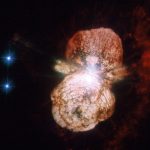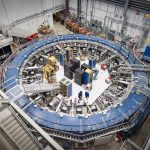News
It’s always great when every one of Fermilab’s nine particle accelerators are turned on and provide beam. With the lab again firing on all accelerator-cylinders, we thought it would be a good time to provide a rundown of each of the members of Fermilab’s accelerator complex. Get to know Fermilab’s suite of accelerators and storage rings.
Particle detectors recorded neutrinos from supernova SN1987A hours before telescopes saw the first light. Thirty years later, scientists around the world are eager to detect neutrinos from another one. The international Fermilab-hosted Deep Underground Neutrino Experiment will be looking for them. These neutrinos can tell us more about supernovae themselves and may hint at new physics that could upend the Standard Model of particle physics.
Respondents to Symmetry’s survey about what it’s like to earn a Ph.D. in particle physics or astrophysics offer their views of the experience. Nearly 2,000 people worldwide complete the scientific rite of passage each year. Yet for many people, the process remains mysterious.
The more than 300 responses to Symmetry’s survey described a challenging, multifaceted experience that goes far beyond job training, and even beyond the scientific goal of studying the fundamental nature of the universe.
From WDCB’s First Light, March 24, 2019: Brian O’Keefe interviews Fermilab PIP-II Project Director Lia Merminga about PIP-II, an accelerator project critical to the lab’s future. Fermilab broke ground on PIP-II on March 15. Learn about how PIP-II will power the international Deep Underground Neutrino Experiment, hosted by Fermilab, and the lab’s experimental program in this 15-minute piece.
Muon g-2 has begun its second run to search for hidden particles and forces. Muon g-2 collaborators have performed upgrades to improve the experiment’s precision and increase the amount of data it generates. As the experiment starts up again, scientists expect to make the world’s most precise measurement of the muon’s anomalous magnetic moment, which could tell us whether additional, undiscovered particles exist in the universe.
From Gizmodo, March 20, 2019: The Proton Improvement Plan II, formally approved by the Department of Energy last summer, includes plans for the highest-energy linear particle accelerator to accelerate a continuous stream of protons — a central component to the American particle physics laboratory. Fermilab PIP-II Project Director Lia Merminga is quoted in this article.
From University of Chicago news, March 15, 2019: Fermilab officially broke ground March 15 on a major new particle accelerator project that will power cutting-edge physics experiments for many decades to come. The new 700-foot-long linear accelerator, part of the laboratory’s Proton Improvement Plan II, will be the first accelerator project built in the United States with significant contributions from international partners.
From Space Daily, March 19, 2019: A major new physics facility at Fermilab is expected to have UK technology at its heart and lead to significant spin-off opportunities for UK companies.
The new PIP-II particle accelerator will power the Deep Underground Neutrino Experiment, which aims to address key questions about the origins and structure of the universe. The UK has committed a 65 million-pound investment to help build and operate DUNE, PIP-II and technology for the neutrino beam.
From MeteoWeb, March 18, 2019: Si è tenuta il 15 marzo al Fermilab, negli Stati Uniti, la cerimonia di posa della prima pietra di uno dei più importanti progetti per il futuro della fisica, in cui l’Italia porta un contributo tecnologico e scientifico di primo piano. Si tratta del progetto PIP-II per la realizzazione di un nuovo acceleratore lineare superconduttore, lungo 215 metri: una delle macchine più avanzate per la ricerca in fisica fondamentale che avrà il compito di produrre il fascio di neutrini di alta energia più potente del mondo per il progetto DUNE.




